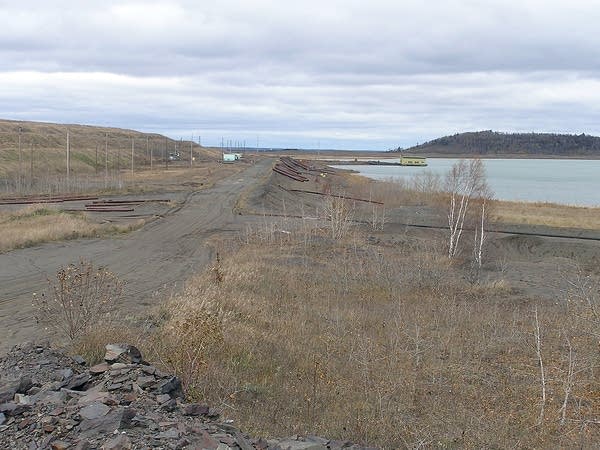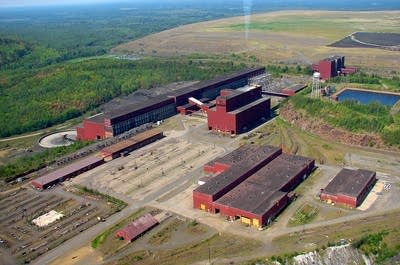PolyMet takes next steps for controversial mine
Go Deeper.
Create an account or log in to save stories.
Like this?
Thanks for liking this story! We have added it to a list of your favorite stories.

Plans are moving ahead for a copper-nickel mine in northeastern Minnesota, a type of mining new to the state, but in other parts of the world similar mines are polluting rivers and lakes.
The old LTV mine north of Aurora, on the eastern edge of Minnesota's Iron Range, is a bleak, windswept place, ringed by piles of waste rock. They look like flat-topped pyramids, about as high as a 20-story building. Eight years ago, the mine closed and the company went bankrupt, and now the hills are covered with grasses and young trees.
LaTisha Gietzen watched as workers cleaned up the land where the old pellet plant has been torn down. Gietzen is Vice President for Public, Environmental, and Governmental Affairs at PolyMet Mining.
PolyMet plans to use some of the 60-year-old buildings, and the expensive machinery in them, to coax copper, nickel and other metals far more valuable than taconite out of the rock.
Turn Up Your Support
MPR News helps you turn down the noise and build shared understanding. Turn up your support for this public resource and keep trusted journalism accessible to all.
"It's a huge asset for the state to have," Gietzen said. "To be able to reuse this existing infrastructure is an excellent opportunity for all of us."
PolyMet bought the buildings, the railroad track, and the electric substation. Six miles to the northeast, PolyMet wants to dig in a 4,300-acre tract of forested land for copper, nickel, and the precious metals platinum, palladium, gold, and cobalt.
The U.S. Forest Service owns that tract of land, but PolyMet owns the minerals beneath the surface. The two are negotiating a land exchange, in which PolyMet would add comparable acreage to the Superior National Forest in exchange for the piece with high mineral value.

Geologists have known for years that those metals are there, locked up in a formation called the Duluth Complex. Now, the rise of robust economies in the developing world means there's profit to be made in extracting and purifying them. Half a dozen other exploration companies have staked out claims along the geological formation.
The minerals to be mined are used for everything from batteries to catalytic converters to artificial joints.
But this kind of mining is different from iron or taconite mining. The valuable minerals are part of sulfide rock. When that rock is brought to the surface and exposed to air and water, the sulfur in the rock links with hydrogen and oxygen in the atmosphere to form sulfuric acid.
That means water that runs off the piles of waste rock can be so acidic that nothing can live in the streams or wetlands where the water flows. The acid water can also pull heavy metals such as arsenic and manganese out of the ground it flows over, further contaminating the water.
The U.S. EPA calls acid rock drainage an "enormous environmental problem," and said the industry has only developed "rudimentary" techniques to control it.
At the PolyMet site, LaTisha Gietzen said the mine is designed to keep a lot of the sulfur out of the environment. She said PolyMet will actually use some of the sulfur as fuel.

"It's important for us to collect the sulfur, because it's tied to the metal, we use the sulfur as a fuel for the process and collect and produce the metals," Gietzen said.
But there will be a lot of waste rock. PolyMet plans to process 32,000 tons of ore a day. The waste will be piled up in hills covering several hundred acres next to the mine pit.
Gietzen said, even though most of the rock has very low amounts of sulfur in it, the company will put all the waste rock on synthetic liners and capture the water running off the piles, and treat the water to remove the heavy metals.
"And that's only part of the treatment," she said. "You do that while you're in operation, and then you put a heavy-duty cover over it to eliminate the water coming in contact with the rock."
It's hard to picture a liner that could withstand the pressure and sharp edges of tons and tons of rock.

"But it's just like a landfill," Gietzen said. "You drive heavy machinery and push garbage into landfills that are similar to what we're doing with our stockpiles."
Still, PolyMet predicts that some amount of acidified water will escape and enter the groundwater system that feeds wetlands and rivers for miles around, all the way to Lake Superior.
The company said that water will meet state standards for drinking water.
But Len Anderson, a retired biology teacher, said a drinking water standard for humans doesn't mean much to the fish. Anderson has made it his life's work to clean up the St. Louis River. His canoeing maps detail the watershed that could be affected by the PolyMet mine -- from the Partridge River and the Embarrass River, 100 miles down the St. Louis River to Lake Superior.

These waters have a lot of mercury in them. Elemental mercury, the kind you played with in high school chemistry lab, doesn't cause much of a problem. But bacteria living in the water can convert that mercury to an organic form, called methyl mercury, and that's when it gets into the fish. Fish advisories warn that children and pregnant women shouldn't eat certain kinds of fish in the St. Louis River and Lake Superior.
Len Anderson said the sulfate in the acidified water is just what the bacteria need to convert more mercury to the methyl mercury form.
"If you give them that extra shot of sulfate, you're going to get an extra shot of methylation," Anderson said. "And that's why the higher the dose upstream, the more damage it does downstream."
Sulfate is also bad for wild rice. Anderson said in his canoe trips he's seen healthy stands of wild rice upstream from the old LTV mine, and stunted growth below it. He said that would only get worse with the higher sulfate runoff from a copper-nickel mine.
Minnesota has never had a copper-nickel mine, but the state does have a little experience with the kinds of problems they create.

Just north of the area where PolyMet plans to mine, there's a place where LTV used to mine taconite. It's right on the edge of the same Duluth complex formation that PolyMet wants to exploit. LTV unearthed some sulfide rock and pushed it aside as waste. For decades, the Dunka mine has been leaching acidified water and toxic metals. LTV's bankruptcy has complicated efforts to clean it up.
Len Anderson and other critics say that's just the kind of experience they don't want to see repeated.
"Across the world this type of mining creates a legacy of acid mine drainage and heavy metal seepages," Anderson said. "This company has no experience, and the state of Minnesota has none."
He said the DNR's Lands and Minerals division is used to taconite operations, which pose a far smaller threat to the environment than sulfide mining.
"Lands and Minerals are gung-ho for metallic sulfide mining, but they have no experience except for Dunka, which they have screwed up royally," he said.
The Dunka mine was developed in the early 1960s, before stringent rules were in place. Since then, the current owner has capped the waste rock with plastic liners, and built wetlands to treat the water running off the piles. The DNR says the wetlands do pretty well at capturing most of the contamination.
The Environmental Impact Statement is being written by the Minnesota DNR and the U.S. Army Corps of Engineers. Several cooperating agencies have commented on various drafts of the document.
The federal Environmental Protection Agency has said it would like more information about financial assurance -- that's a requirement that PolyMet set aside money to cover any clean-up needed after the mine closes. The EPA also pointed out that the study only documents mitigation for about two-thirds of the damage to wetlands that would occur with the mine.
Scientists for the Fond du Lac, Grand Portage, and Bois Fort bands of Ojibwe have expressed concerns about the impact of possible sulfate pollution on wild rice. They also question how long the water might need to be contained and treated after the mine closes.
The DNR said details about the financial assurance requirement and mine closure won't be known until later -- when PolyMet applies for permits to begin mining.
The DNR said the Environmental Impact Statement is not designed to figure out whether the mine can be done without harming the environment. Rather, it lays out the possible harms, and outlines some ways to prevent or lessen them.
The draft of the environmental review of the project is expected Friday.
The public will have a chance to comment on the study. The normal comment period is 45 days, but many groups have requested more time.
---
Editor's note: Because of editing/transcription errors, the mine's processing capacity was incorrect, and a paragraph was omitted from an earlier version of this story.




